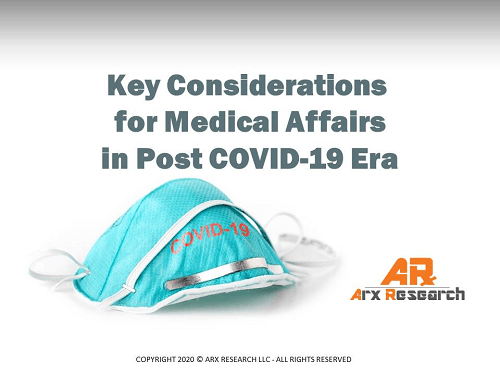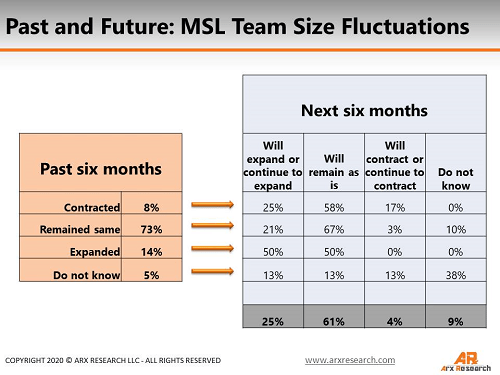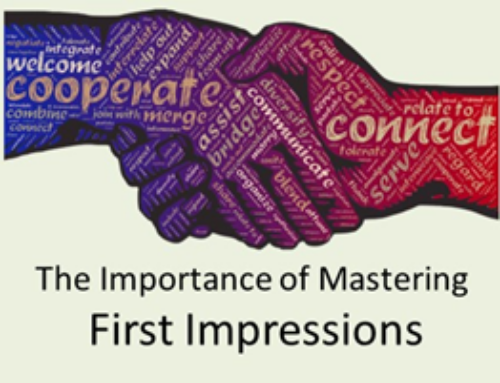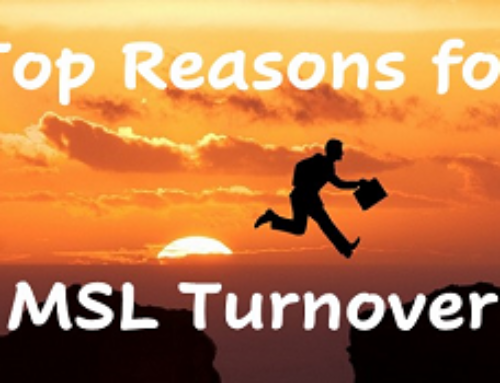Medical Affairs Key Considerations in Post COVID-19 Era presents results of the impact of the global shutdown on MSL teams. It also provides key take-aways to address and outlines a few challenging hurdles to overcome in the near future. Arx Research conducted a brief survey to assess how the COVID pandemic reshaped the Medical Science Liaison role and Medical Affairs organizations worldwide.
What Happened?
Fresh study results show Medical Science Liaison teams were fairly unaffected by the impact of the COVID-19 pandemic , with close to 90% of study respondents reporting their team either remained the same in terms of number of MSLs on the team, or expanded during the past six months (up to April 2020).
Less than 10% of survey takers indicated their team contracted in size during that period. This is good news and shows the stability of the role as well as the necessity of the function.
We suspect that since the role of MSL is largely home based with lots of travel, it was easier to conform to quarantine guidelines as the personal set-ups allowed for less complicated adaptation. On the other side of this were organizational demands. Since the majority of life science professionals, if not all, had to stay homebound (and still is the case for many), the pain of a somewhat standstill operation was felt throughout all levels of the organization. The same applies for thought leaders and HCPs, although some practitioners may have had to redirect their efforts to COVID patients if their competencies could be helpful. All in all, any face-to-face interaction – visits, meetings, conferences – were all off.
Nonetheless, and although the pace of work was decelerated, pharma organizations continued to operate and MSLs reported maintaining interactions with thought leaders, healthcare providers and team members.
What’s Next?
While teams were affected in various ways, only 4% of all study respondents expect their team to experience reduction or further reduction in the number of team members. The majority of teams that experienced contraction in the past six months will stabilize (58%), while 17% indicated their team will continue to contract.
For the teams that remained unscathed and the ones which expended, 26% reported they will either expand or continue to expand in the next six months, while 64% of these will remain as they are.
Overall, 86% of respondents expect their team to remain as they are or expand within the next six months, which is both very positive for MSLs and for maintaining the relationships that were built with thought leaders. Promising, but the Medical Affairs function will have to adopt new rules for thought leader engagement, at the least for the near future. Here are some medical affairs key considerations to take into account while moving forward.
Medical Affairs Key Considerations #1: Impact on Medical Science Liaisons
These days, the MSL can be perceived as a “propagator”… unfortunately not of scientific information in this case, but of diseases. The nature of the MSL job involves a lot of travel and this can be seen as a high-risk disease transmitter role. Therefore, MSLs will be affected, in the near term, by limited if not restricted access to institutions.
Past MSL metrics research showed virtual interactions consisted of the smallest fraction of a MSL means of communication (average is 5 per year per KOL compared to 12 face-to-face visits). During the stay-at-home orders, it is easy to imagine virtual interactions toppled all other communication metrics.
Medical Science Liaisons should be, by now, more familiar with the various virtual technologies and should really embrace it, and learn the ins-and-outs of it because it will be the new norm from hereon.
“We will need to adapt to these digital interactions and to digital meetings and events. There is also a need to adapt the way we communicate and to understand which KOLs are more willing to engage in digital projects and which ones need our support to adapt to this new reality”.
Field Medical Advisor, Portugal
The downside of virtual visits is they can be ignored more easily by KOLs than a scheduled on-site face-to-face meeting. This will require Medical Science Liaisons to be more creative in developing a virtual meeting “style” or format that will be both appealing and suit the thought leaders’ receptive sensors. Educating thought leaders to adopt or ease themselves into the newer communication methods more intensively than before might also be required, which brings another level of responsibility from MSLs and Medical Affairs organizations.
“… in Brazil the KOLs are not receptive to virtual interactions”
Medical Science Liaison, Brazil
But a larger issue is at stake here. Establishing new relationships will be a much more difficult task in a virtual world. Until there is a medical solution found to halt the spread of the disease, normal social behaviors to meet, shake hands and get a “personal feel” for individuals will be put aside. Therefore, the development of new relationships will mostly have to be done through virtual, phone and email means, which removes a lot of the personal touches.
Many MSLs also take advantage of large gatherings such as conferences to approach multiple thought leaders, either as existing or potentially new relationships, within a short timeframe. While the world is reopening cautiously, many events will be conducted through online channels, where personal approaches will almost be non-existent. This will impede new relationship development. It will then be imperative for MSLs to maintain and nurture existing relationships to minimize erosion of their KOL “call” list.
“Online channels will play a bigger role in future for MSLs but by returning to the new normal, I believe we will be visiting the HCPs in the field too. However, I see this process as an opportunity for us to utilize the digital tools into our daily routine for the future, when the pandemic is over. “
Medical Advisor, Turkey
Medical Affairs Key Considerations #2: Impact on the Medical Affairs Organization
It will be easier for companies who already have adopted and implemented digital transformation to adapt to a more virtual approach to operating. Although MSLs are usually fairly flexible and adaptable to working remotely, a more permanent setup will be required.
“Medical Science Liaisons, as well as all the Medical Affairs management, support staff and related functions, will have to enhance their digital skills and communication techniques through integrated multichannel methodologies”
Medical Affairs Director, United States
Organization should consider assessing their technological and communication skills training needs, to ensure all remote personnel are fully able to use the technology for seamless communications. Organizations should also look into the technological needs and hardware of remotely based MSLs. Working out of a laptop might be fine for short periods of times, but with a new normal that looks more to be permanent remote work, organizations should provide MSLs with the proper equipment and tools to operate efficiently. Medical Affairs teams should also develop attractive interactive models that will entice thought leaders and HCPs to engage and improve the MSLs’ work.
In the short term, most of the travel to meet with thought leaders and HCPs will be halted for reasons cited above. But there will still be activity on that front for essential needs. And as the world reopens and people get increasingly comfortable with face-to-face interactions, and when travel ramps up, there will still be high awareness of risks.
This means organizations will need to provide personal protective equipment (PPE) to keep MSLs – and the people there are in contact with – safe, due to high amount of travel and exposure to a multitude of people, medical professionals and patient sites (planes, rental cars, hotels, hospitals, clinical and academic research sites, private practices and so on).
With lower travel expenditures, organizations should redirect the cost savings into investments in technology, home and personal protection equipment.
Medical Affairs Key Considerations # 3: Impact on MSL and Medical Affairs Performance Metrics
With less travels comes more time available to perform other tasks. Past research shows travel accounts an average 10% of a MSL’s time (much more for larger territories) while spending upward of 30% of their time on meeting with and educating KOLs as well as attending conferences and delivering group presentations. With personal face-to-face interactions temporarily on hold and significantly altered in the future, Medical Affairs management will have to revamp how they assess MSL’s performance.
In the past, our research tracking MSL performance criteria showed organizations mostly relied on the quality of relationships (based on various indicators) and on the quantity of interactions, or visits, that Medical Science Liaisons were conducting with thought leaders, set by organizational objectives. While the first key metric will probably stand – quality of relationship is primordial – the visits metric will need to reflect the new reality of virtual engagements.
“I proposed a virtual meeting for our scientific collaboration and for the monitoring of ongoing clinical trials! I think this a solution for the moment and for the near future!”
Medical Science Liaison, Italy
Activities such as monitoring of clinical trials and sharing of scientific documentation for instance, could more easily be moved to digital channels, while securing speakers and advisory boards participants might present a bit more challenging. In-person attendance of congresses and medical meetings will have to be on hold for now.
MSLs and management will need to rethink how currently established performance metrics of a primarily field-based role will now need to be reviewed and adjusted to account for the limitations of a redesigned digital medical advisory role, and optimize the opportunities it presents.







